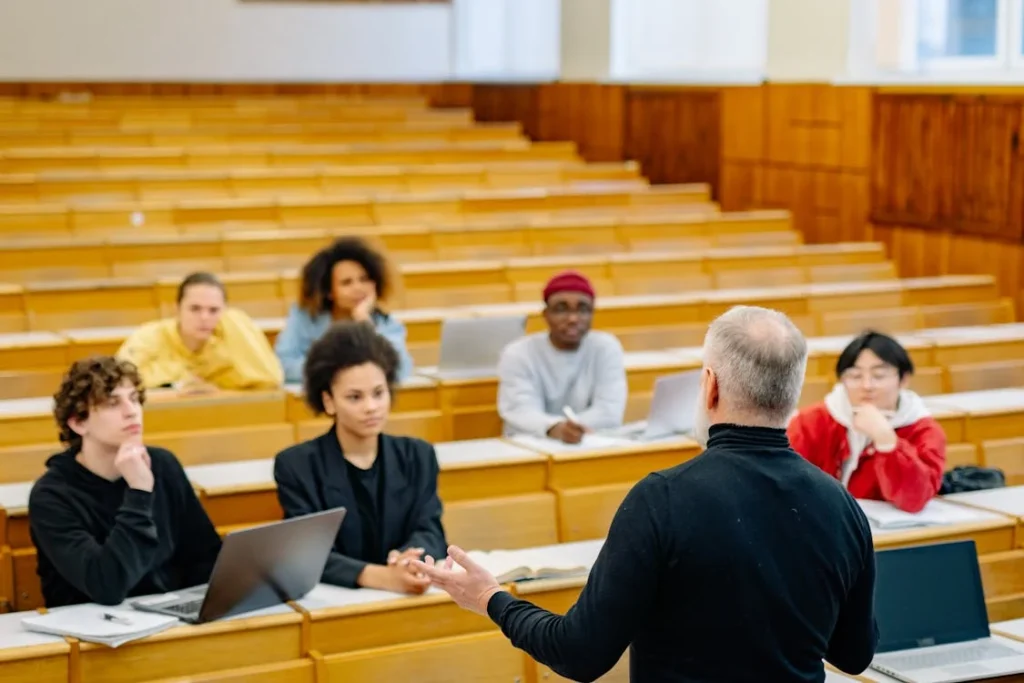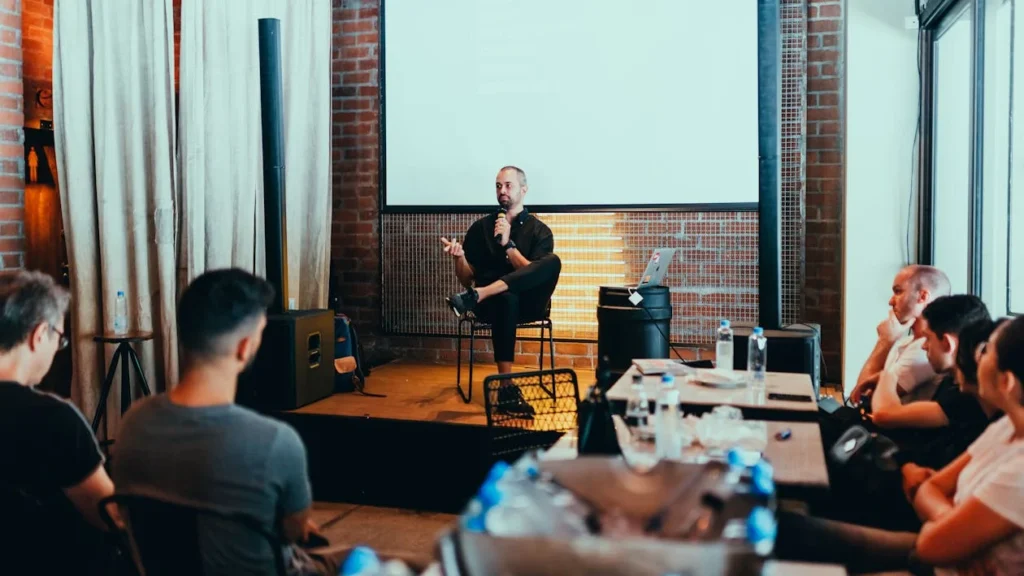Events and conferences are meant to bring people together, share knowledge, and create opportunities. However, for individuals with disabilities, attending these gatherings can often be challenging due to physical, sensory, or communication barriers. Ensuring that events are accessible is not just about compliance—it is about inclusivity, respect, and creating an environment where everyone can participate fully.
Making events accessible requires careful planning and thoughtful design. From venue selection to digital accessibility, every detail matters in ensuring that all attendees, regardless of ability, have an equal and enjoyable experience. In this article, we’ll explore how event organizers can create truly inclusive events that welcome and support people with disabilities.

Choosing an Accessible Venue
The foundation of an inclusive event starts with selecting the right venue. A location that is physically accessible, easy to navigate, and equipped with essential facilities ensures that attendees with disabilities can participate comfortably.
When evaluating a venue, it is important to consider entrances, seating arrangements, restrooms, and emergency exits to ensure they are designed for people of all abilities.
Ensuring Step-Free Access and Mobility-Friendly Layouts
A truly accessible venue should have step-free entrances or ramps with proper handrails. If the event is held in a multi-level building, there must be functional elevators that are wide enough for wheelchairs and mobility aids.
Narrow hallways, high thresholds, and steep inclines can create difficulties for attendees with mobility impairments.
Once inside, the event layout should allow smooth and unobstructed movement. Walkways must be wide enough for wheelchairs and guide dogs, with clear signage directing attendees to different areas.
Seating arrangements should include reserved spaces for wheelchair users and individuals with limited mobility, ensuring they can participate comfortably without being placed in the farthest corners of the room.
Accessible Restrooms and Seating Areas
Restrooms must be fully accessible, with wide doors, grab bars, and enough space for a wheelchair user to maneuver. A well-equipped venue should have at least one designated accessible restroom on each floor.
If the venue lacks these facilities, event organizers should consider renting portable accessible restrooms.
Seating arrangements should also prioritize comfort and accessibility. For example, chairs should not be too tightly packed, and there should be options for adjustable seating or cushioned chairs for individuals who require extra support.
A mix of seating styles ensures that people with different needs can find a comfortable spot.
Clear Signage and Wayfinding
Navigating an unfamiliar space can be challenging for people with visual impairments, cognitive disabilities, or mobility limitations.
Clear, high-contrast signage with large fonts and braille helps attendees move around independently. If possible, digital wayfinding tools such as audio-based navigation apps or interactive maps should be provided to guide attendees to their destinations.

Making Communication and Content Accessible
An inclusive event is one where every attendee, regardless of their sensory or cognitive abilities, can fully engage with presentations, discussions, and networking opportunities.
To achieve this, organizers must ensure that all communication methods, visual materials, and spoken content are accessible to people with disabilities.
Providing Live Captions and Sign Language Interpretation
For attendees who are deaf or hard of hearing, live captions and sign language interpretation are essential.
Captions should be displayed in real time during presentations, panel discussions, and Q&A sessions, ensuring that attendees can follow along without missing important details.
Professional captioning services or AI-powered live transcription tools can help deliver accurate, real-time text.
Sign language interpreters should be present for key sessions, and their placement must be carefully considered.
They should be positioned in a well-lit area that is visible to the audience, ensuring that attendees who rely on sign language can see their gestures clearly.
If an event has multiple sessions running simultaneously, organizers should ensure that sign language interpretation is available in each session upon request.
Offering Alternative Formats for Presentation Materials
Event organizers should provide presentation slides, brochures, and informational materials in multiple formats. Large-print versions, braille copies, and digital formats compatible with screen readers ensure that individuals with visual impairments can access content easily.
Digital materials should be formatted with high contrast, clear fonts, and alt-text for images so that screen-reading software can interpret them correctly.
For individuals with cognitive disabilities, information should be presented in clear, structured, and easy-to-understand language.
Avoiding overly technical jargon and breaking down key points into digestible sections helps make content more inclusive.
Providing pre-event access to presentation materials allows attendees to review content in advance and come prepared with any necessary assistive tools.
Ensuring Accessible Microphones and Audio Systems
Clear audio is crucial for an inclusive event, especially for attendees who rely on hearing aids or assistive listening devices. The event venue should have high-quality microphones and sound systems that deliver crisp, clear audio.
Speakers should be instructed to speak at a steady pace, use clear articulation, and repeat audience questions before answering them.
Wireless microphones should be available for attendees with mobility impairments who may not be able to walk to a microphone stand during Q&A sessions.

Ensuring Digital and Virtual Accessibility
With the rise of hybrid and virtual events, accessibility must extend beyond the physical venue. Many conferences now offer online participation options, and it is crucial that these digital platforms are fully accessible to attendees with disabilities.
From live-streaming sessions to interactive discussions, digital inclusion ensures that everyone can engage with the event, regardless of their location or abilities.
Choosing an Accessible Event Platform
For virtual attendees, the event platform must support screen readers, keyboard navigation, and voice commands.
Platforms like Zoom, Microsoft Teams, and Google Meet already include accessibility features such as live captions, screen magnification, and high-contrast modes. However, organizers should test these features beforehand to ensure they function correctly.
Chat functions and Q&A sections should be designed with accessibility in mind. Some attendees may use speech-to-text software or alternative input methods, so it is important that the platform allows easy text input and responses.
If polls, surveys, or interactive elements are included, they should be compatible with screen readers and easy to navigate without using a mouse.
Live Captioning and Sign Language Interpretation for Virtual Attendees
Just as in-person attendees benefit from live captions and sign language interpretation, these features must also be available for virtual participants.
Live captions should be accurate, synchronized, and available in multiple languages if the event has an international audience. AI-generated captions can be a starting point, but human captioning services ensure higher accuracy.
For sign language users, the virtual platform should allow a dedicated window for interpreters, so their signing remains visible at all times. Platforms that support customizable screen layouts give attendees the flexibility to resize or reposition interpreter windows as needed.
Accessible Digital Documents and Event Websites
The event website should follow web accessibility standards (WCAG 2.1) to ensure that people with disabilities can access information effortlessly. This includes:
- Readable fonts and high contrast color schemes for individuals with visual impairments.
- Keyboard-friendly navigation for those who cannot use a mouse.
- Alt-text for images to ensure screen readers can describe visual content.
- Easy-to-follow page structure with clear headings and logical tab order.
Event registration forms must also be accessible. Forms should avoid CAPTCHA tests that require visual identification, as these can be challenging for blind users. Instead, offering an audio CAPTCHA or alternative verification method ensures inclusivity.
Making Networking Accessible for Virtual Participants
Networking is a key part of events and conferences, and virtual attendees should have the same opportunities to connect with others. Breakout rooms, chat functions, and one-on-one video calls must be designed for accessibility.
Providing multiple ways to interact—such as text-based chats, voice-only discussions, and video calls with captions—ensures that all attendees can participate comfortably.

Providing On-Site Assistance and Support
Even with the best planning, unforeseen accessibility challenges can arise during an event. Having dedicated support in place ensures that attendees with disabilities receive immediate assistance when needed.
A well-prepared event team can make all the difference in creating a welcoming and stress-free experience for everyone.
Designating an Accessibility Coordinator
One of the most effective ways to ensure inclusivity is to have a dedicated accessibility coordinator on-site. This person is responsible for overseeing accessibility features, assisting attendees with disabilities, and addressing any issues that may arise.
The accessibility coordinator should be trained in disability etiquette, knowledgeable about available accommodations, and easily reachable throughout the event.
Event staff and volunteers should also receive disability awareness training before the event.
They should understand how to assist individuals with mobility impairments, communicate effectively with people who are deaf or hard of hearing, and provide guidance to individuals with visual impairments.
A well-trained team ensures that every attendee feels respected and supported.
Offering Personal Assistance and Guided Support
Some attendees may require additional support during the event, such as sighted guides for individuals who are blind, personal assistants for those with mobility challenges, or interpreters for nonverbal attendees.
Organizers should provide an option for attendees to request personal assistance in advance when registering for the event.
For large venues, having volunteers stationed at key locations can help guide attendees to different areas, assist with seating arrangements, or provide any necessary information.
If possible, having mobility aids available on-site, such as wheelchairs or electric scooters, can assist attendees who may need temporary support.
Ensuring Accessibility for Dietary Needs and Refreshments
Food and beverage stations should be designed with accessibility in mind. This includes providing space for wheelchair users to reach serving tables, offering seating options close to dining areas, and ensuring that labels are clear and easy to read.
For individuals with visual impairments, braille menus or digital menus with screen reader compatibility can improve accessibility.
For attendees with dietary restrictions, such as food allergies or medical conditions, event organizers should ensure that allergen-friendly and medically necessary food options are available.
Servers and catering staff should be trained to communicate food ingredients and provide alternative meal options if needed.
Emergency Preparedness and Evacuation Plans
Safety is a top priority, and accessibility must be considered in emergency preparedness plans.
Every event should have clear evacuation procedures that include plans for attendees with mobility impairments, sensory sensitivities, or cognitive disabilities.
Accessible emergency exits, visual and auditory alarms, and trained staff to assist in evacuations are crucial for ensuring safety.
Attendees should be informed of emergency procedures at the beginning of the event, and signage indicating accessible exits should be clearly visible throughout the venue.
For virtual events, organizers should provide clear instructions on how to get support in case of technical issues or emergencies during live sessions.

Promoting Inclusivity Before, During, and After the Event
Accessibility doesn’t begin when attendees arrive at the venue—it starts with pre-event planning and continues long after the event concludes.
Ensuring that accessibility is a priority at every stage of an event helps create a welcoming experience for all participants. From marketing and registration to post-event follow-ups, inclusivity must be built into every interaction.
Making Event Promotion and Registration Accessible
The way an event is promoted determines who feels welcome to attend.
Marketing materials should clearly state that the event is accessible and inclusive, listing the available accommodations such as wheelchair access, sign language interpreters, captioning, assistive listening devices, and dietary accommodations.
This transparency helps attendees with disabilities plan ahead and feel confident about participating.
All promotional materials—whether on websites, emails, or social media—should be designed with accessibility in mind. Videos should have captions, images should include alt-text, and website pages should be compatible with screen readers.
Social media announcements should avoid using text-heavy images without descriptions, ensuring that people with visual impairments can access the information.
The registration process must also be inclusive. Online forms should be accessible with screen reader compatibility, high-contrast text, and keyboard navigation.
Attendees should be given the option to request accommodations in advance, such as accessible seating, mobility assistance, or interpreters.
Encouraging an Inclusive Event Culture
Beyond logistics, the overall atmosphere of an event plays a huge role in making attendees feel welcome. Organizers, speakers, and attendees should be encouraged to embrace inclusivity and respect individual needs.
Speakers should be briefed on accessible presentation techniques, such as describing visual slides aloud for blind attendees, using microphones consistently, and speaking at a moderate pace for captioning accuracy.
Attendees should be encouraged to respect accessible seating areas, avoid blocking pathways, and be mindful of individuals with sensory sensitivities.
Creating a designated quiet space can be helpful for individuals with sensory processing disorders, anxiety, or fatigue. This space should be away from loud sounds, bright lights, and high foot traffic, allowing attendees to take breaks when needed.
Gathering Feedback for Continuous Improvement
Accessibility is an ongoing process, and the best way to improve future events is by gathering feedback from attendees with disabilities.
After the event, organizers should send out accessible feedback forms that allow attendees to share their experiences, challenges, and suggestions. These forms should be available in multiple formats, such as digital text, voice-recorded options, or braille upon request.
Encouraging honest feedback helps event organizers identify areas for improvement, ensuring that future events become even more inclusive.
Following up with attendees and letting them know how their feedback has been implemented shows a genuine commitment to accessibility.
The Long-Term Impact of Inclusive Events
When events prioritize accessibility, they create a lasting impact on attendees, businesses, and the broader community.
Ensuring that people with disabilities can participate fully in conferences, networking events, and industry gatherings opens doors to new opportunities, stronger connections, and a more diverse exchange of ideas.
By making accessibility a fundamental part of event planning, organizers contribute to a more inclusive society where everyone, regardless of ability, has the chance to learn, contribute, and connect.
The goal is not just to meet accessibility requirements, but to create environments where all individuals feel valued and empowered.

The Role of Technology in Enhancing Event Accessibility
Technology is playing a crucial role in making events and conferences more inclusive. From assistive devices to AI-powered accessibility tools, innovative solutions are helping organizers remove barriers and create seamless experiences for attendees with disabilities.
As digital transformation continues, event planners must leverage these tools to enhance accessibility before, during, and after an event.
AI-Powered Accessibility Features
Artificial intelligence (AI) is revolutionizing event accessibility by offering real-time language translation, automated captions, and speech-to-text services.
AI-driven captioning tools can instantly transcribe presentations, ensuring that attendees who are deaf or hard of hearing have equal access to spoken content.
Real-time translation services powered by AI are also making global events more inclusive. Attendees who communicate using different languages—including sign languages—can participate fully, whether in person or virtually.
AI can also generate audio descriptions for slides, presentations, and videos, making visual content accessible to blind or low-vision attendees.
Virtual Reality (VR) and Augmented Reality (AR) for Inclusive Participation
Virtual and augmented reality are creating immersive accessibility solutions for attendees with disabilities. For individuals with mobility impairments, VR can offer virtual event experiences, allowing them to navigate the venue and interact with other participants from home.
AR applications are being used to provide interactive wayfinding assistance inside large venues. Through smart glasses or smartphone apps, attendees with visual impairments can receive real-time directions to event locations, booths, or restrooms.
These tools enhance independence, reducing the need for constant assistance.
Smart Wearables for Personalized Assistance
Wearable technology is enhancing event accessibility by providing real-time assistance through haptic feedback, voice guidance, and sensory alerts.
Smart glasses with built-in text-to-speech technology can help attendees with visual impairments by reading out event schedules, speaker names, and booth details.
For individuals with hearing impairments, smart hearing aids with AI-driven noise filtering improve sound clarity during presentations.
Wearable devices that vibrate in response to important announcements or emergency alerts also help attendees stay informed in crowded or noisy environments.
Mobile Apps for Real-Time Event Support
Many conferences now offer event-specific mobile apps with built-in accessibility features. These apps allow attendees to:
- Access event schedules in multiple formats, including screen-reader-friendly text.
- Receive instant updates about session changes or accessibility accommodations.
- Connect with on-site accessibility teams for immediate assistance.
Attendees with disabilities can use these apps to request sign language interpreters, mobility assistance, or quiet spaces, ensuring that they receive the support they need without delays.
Hybrid Events: Expanding Accessibility Through Virtual Participation
Hybrid events—where attendees can participate both in person and online—are becoming increasingly popular. This model greatly benefits individuals with disabilities who may face challenges traveling to a physical venue.
For virtual participants, ensuring that live streams have captions, sign language interpretation, and easy-to-navigate digital platforms is crucial.
Organizers must also provide multiple communication options, such as chat-based Q&As, voice interaction, and screen reader-compatible menus.
By integrating technology into event planning, organizers can create a truly inclusive experience that allows all attendees—regardless of ability—to engage, learn, and network without barriers.

The Business and Social Benefits of Hosting Accessible Events
Ensuring accessibility at events and conferences is not just a matter of compliance—it is a step toward building a more inclusive and equitable society.
Organizations that prioritize accessibility are not only creating opportunities for individuals with disabilities but also enhancing their reputation, expanding their audience, and fostering innovation.
Reaching a Larger and More Diverse Audience
When an event is accessible, it attracts a wider and more diverse group of attendees. People with disabilities make up a significant portion of the population, and ensuring their full participation means expanding an event’s reach.
Businesses, educational institutions, and professional organizations that invest in accessibility can connect with a broader talent pool, increase their customer base, and build a reputation as inclusive leaders.
For global events, accessibility also means ensuring that language barriers do not exclude participants.
Features such as real-time translations, multi-language captions, and accessible digital platforms make events more inclusive for international audiences, ensuring that no one is left out due to language or communication differences.
Strengthening Brand Reputation and Social Impact
Organizations that actively promote accessibility demonstrate a strong commitment to diversity, equity, and inclusion (DEI).
Hosting accessible events reinforces a brand’s values and attracts positive attention from customers, employees, and stakeholders who prioritize inclusivity. Companies that lead in accessibility often gain greater public trust, media recognition, and stronger brand loyalty.
By ensuring that all attendees—regardless of physical, sensory, or cognitive abilities—can participate without barriers, event organizers create a space where everyone feels welcome and valued.
This fosters a sense of belonging, encourages collaboration, and strengthens professional relationships.
Encouraging Innovation Through Inclusive Design
When event planners incorporate accessibility from the start, they inspire innovation in event planning, technology, and user experience design.
Many accessibility solutions, such as voice commands, touch-free navigation, and AI-driven captions, benefit not only individuals with disabilities but also the general audience.
These innovations often lead to better event experiences for all attendees, improving engagement, usability, and satisfaction.
For example, an event with high-quality captions and audio descriptions does not only benefit individuals who are deaf or blind—it also improves comprehension for non-native speakers, attendees in noisy environments, and individuals who process information better through text.
Accessibility-driven innovations often set new industry standards, encouraging others to follow suit.
Strengthening Legal Compliance and Risk Management
In many countries, accessibility at public events is required by law, with strict regulations in place to ensure equal participation for people with disabilities. Failing to meet these legal requirements can lead to penalties, lawsuits, and reputational damage.
By proactively making events accessible, organizations reduce legal risks and demonstrate corporate responsibility.
Ensuring compliance with disability rights laws, web accessibility guidelines, and workplace inclusion policies not only protects businesses but also contributes to a fairer and more equitable society.
Fostering a Culture of Inclusivity and Social Change
Hosting accessible events is a powerful way to drive long-term social change. It raises awareness about the importance of accessibility, educates attendees on inclusive best practices, and sets a precedent for future events.
When people see accessibility in action—whether through sign language interpretation, inclusive seating arrangements, or digital accessibility tools—they become more aware of the barriers that people with disabilities face and the solutions that can remove them.
This encourages more organizations, businesses, and communities to adopt universal design principles, ultimately leading to a world where accessibility is the norm rather than an afterthought.
By making accessibility a priority, event organizers create not just a great experience for attendees but a lasting impact on society.
The goal is not just to remove barriers for a single event but to set new standards for inclusion, ensuring that every future gathering is welcoming, empowering, and accessible for all.
Conclusion
Creating accessible events and conferences is about more than just meeting legal requirements—it is about ensuring that everyone, regardless of ability, can fully participate and engage. From choosing an accessible venue to providing sign language interpretation, captioning, and assistive technology, every step taken toward inclusivity makes a significant difference.
By integrating accessibility from the start, event organizers reach a wider audience, enhance brand reputation, and foster meaningful connections. Whether through digital accessibility tools, inclusive seating arrangements, or hybrid event formats, these efforts ensure that individuals with disabilities are not left out of important discussions and opportunities.
At Robobionics, we are committed to advancing accessibility through innovative prosthetic solutions like Grippy™, designed to empower individuals with limb differences. Just as technology is transforming assistive devices, it is also reshaping how events become more inclusive.
The future of events is accessible, and it starts with thoughtful planning, inclusive design, and a commitment to breaking barriers. If you’re planning an event, take the extra step to ensure it is welcoming for all—because accessibility benefits everyone.



